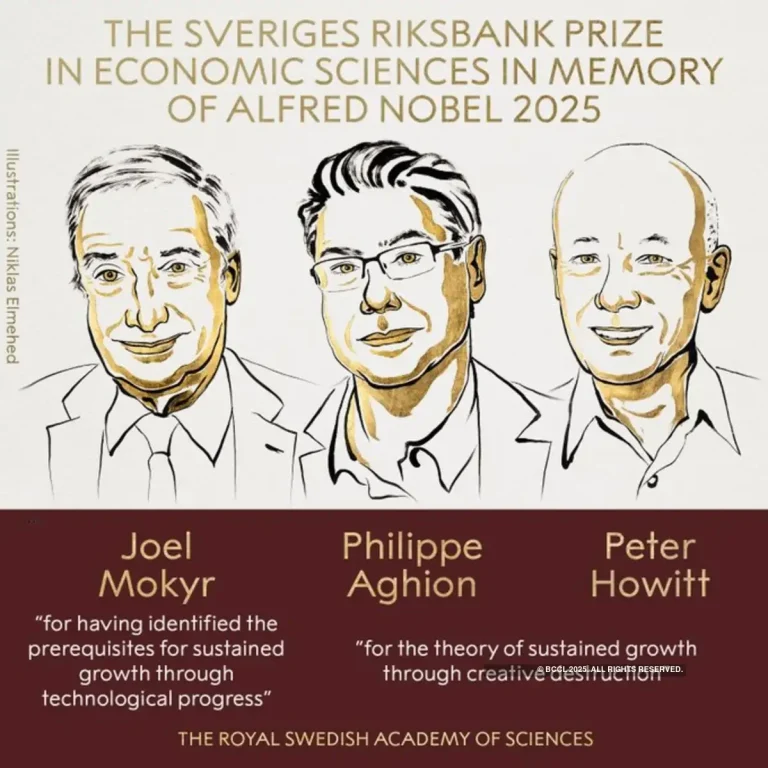The 2025 Nobel Prize in Economic Sciences was awarded jointly to Joel Mokyr, Philippe Aghion, and Peter Howitt for their pioneering work in explaining how innovation drives long-term economic growth. Their research offers a profound understanding of how societies progress from stagnation to sustained prosperity through technological change, scientific advancement, and institutional adaptation.
Joel Mokyr’s Contribution: The Cultural and Knowledge Foundations of Growth
Joel Mokyr, an economic historian, was honoured for uncovering the historical and intellectual conditions that made sustained technological progress possible. He explained that before the Industrial Revolution, human societies experienced occasional bursts of innovation but rarely continuous growth. Mokyr showed that for growth to persist, two kinds of knowledge are essential — “useful knowledge” (knowing how things work) and “propositional knowledge” (knowing why they work).
His research highlighted how Europe, between the 17th and 19th centuries, built an environment where both forms of knowledge interacted productively — through scientific inquiry, experimentation, and open exchange of ideas. This created a self-reinforcing cycle of discovery and improvement. He also stressed the importance of institutions, culture, and tolerance of dissent, arguing that a society must value innovation, reward curiosity, and allow individuals to challenge authority for scientific progress to flourish.
In short, Mokyr’s work answers why the Industrial Revolution occurred where and when it did, and why it led to sustained growth rather than temporary advances. His research bridges economics and history, showing that ideas, values, and institutions are as crucial to growth as physical capital or labour.
Philippe Aghion and Peter Howitt’s Contribution: The Economics of Creative Destruction
Philippe Aghion and Peter Howitt were recognised for developing the theory of innovation-led growth through creative destruction, a formal economic model inspired by Joseph Schumpeter’s classic insight that capitalism advances through cycles of innovation that render old technologies obsolete.
Their 1992 “Aghion–Howitt model” explained how new firms and innovators drive growth by introducing superior technologies, products, and methods that replace older ones. This constant renewal raises productivity and living standards but also causes disruption — firms fail, jobs disappear, and industries transform. They provided the mathematical foundation for understanding this dynamic, showing how investment in research and development (R&D), competition policy, intellectual property rights, and education interact to determine a country’s innovation rate.
Aghion and Howitt also addressed the policy dilemmas of innovation: how to encourage new entrants without discouraging incumbents, how to protect inventors while keeping markets open, and how governments can balance growth with social stability. Their work profoundly shaped modern growth theory and continues to guide policymakers designing frameworks for innovation, entrepreneurship, and competition in the 21st century.
Why Their Work Matters
Together, Mokyr, Aghion, and Howitt transformed how economists understand sustained economic progress. They showed that growth is not a natural or automatic process — it depends on the interaction between knowledge creation, institutional openness, and competition. Their ideas explain not only the origins of the Industrial Revolution but also the challenges of today’s economies facing technological disruption, automation, and inequality.
Their insights guide modern debates on how to design policies that foster innovation without deepening social divisions — through education, R&D incentives, support for startups, and adaptive social safety nets. The 2025 Nobel Committee noted that their combined contributions illuminate “how human creativity, when properly nurtured, can turn progress into a permanent feature of civilization.”
The essence of the mathematical models developed by Philippe Aghion and Peter Howitt lies in their revolutionary reinterpretation of how innovation drives long-term economic growth — a framework known as the Schumpeterian Growth Theory. Their work modernized Joseph Schumpeter’s idea of “creative destruction” into a rigorous, microfounded, and dynamic mathematical model that explains the relationship between innovation, competition, and productivity.
Here are the key takeaways and contributions of their models:
- Endogenous Growth through Creative Destruction:
Unlike older models (like Solow’s), where growth resulted mainly from external technological progress, Aghion and Howitt’s model treats innovation as endogenous — generated within the economy by entrepreneurs and firms seeking profit. Each innovation replaces an older technology, embodying creative destruction — the idea that progress necessarily destroys outdated methods, products, and firms. - Innovation-Driven Productivity:
The model demonstrates that aggregate productivity growth is the result of continuous micro-level innovation. Each innovation improves upon the previous one, meaning technological progress is a cumulative and competitive process. - Competition as a Double-Edged Force:
Their framework shows that competition can both spur and deter innovation. Moderate competition encourages firms to innovate to escape rivals (“escape competition effect”), while excessive competition can reduce profits and thereby lower the incentive to invest in R&D. This insight was crucial in shaping modern industrial and innovation policy debates. - Role of Institutions and Policy:
Aghion and Howitt’s models emphasize that innovation does not thrive automatically; it requires supportive institutions — such as patent protection, access to finance, and openness to entry and exit of firms. Good policies can create a virtuous cycle of innovation-led growth, while rigid, rent-seeking structures can stifle it. - Growth, Inequality, and Structural Change:
Their later extensions link innovation to income inequality and social mobility, showing that while innovation can raise aggregate prosperity, it can also create disparities between innovators and laggards unless education, competition, and redistribution policies are well designed. - Dynamic Nature of Growth:
The Aghion–Howitt framework depicts growth as a perpetual process of renewal, not a steady state. Economies evolve through cycles of technological disruption, adjustment, and further innovation — a far more realistic portrayal than earlier equilibrium-focused models.
In essence, their mathematical models recast capitalism as a dynamic system of continuous innovation and adaptation — driven by human ingenuity, constrained by policy and institutions, and marked by both creative and destructive forces. This work has profoundly influenced how economists, policymakers, and business leaders understand sustainable growth in the modern, innovation-driven world.

